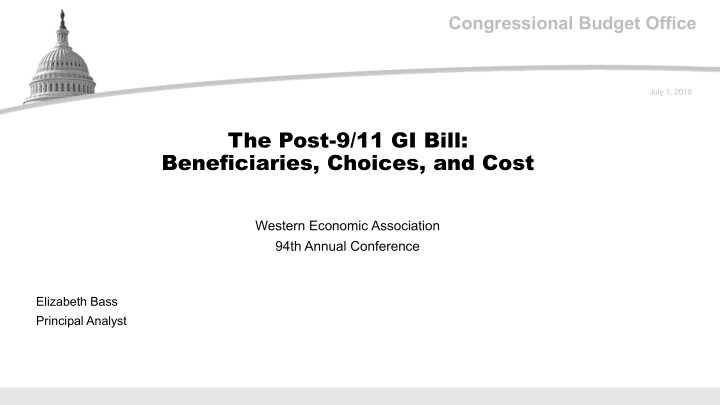



Congressional Budget Office July 1, 2019 The Post-9/11 GI Bill: Beneficiaries, Choices, and Cost Western Economic Association 94th Annual Conference Elizabeth Bass Principal Analyst
CBO Outline Overview of the Post-9/11 GI Bill program Beneficiaries’ usage: CBO’s findings Institutions’ tuition and fees: CBO’s findings 1
CBO Overview of the Post-9/11 GI Bill Program 2
CBO Who Is Eligible? What Programs Are Eligible? Post-9/11 GI Bill took effect in August 2009 –Beneficiaries must have served at least 90 days since September 11, 2001 –No expiration date for using the benefit for veterans who are eligible after January 1, 2013 Benefits are available for active-duty service members or veterans, including members of the National Guard and reserves with qualifying service Benefits are available for certain dependents Definition of institution of higher learning is broad –By statute: institution with an “identified educational, professional, or vocational objective” –Aside from bartending, unclear what type of programs would be denied 3
CBO What Educational Assistance Is Covered? In-state tuition and fees (100 percent) –Private institutions, overseas institutions, and non-degree-granting programs have a tuition cap of $24,477 for the 2019–2020 academic year Housing is equivalent to what the Department of Defense pays for a service member at the E-5 level with dependents for those attending more than half time –Amount of housing assistance depends on locality Various other related supplies and fees Covers 36 months of postsecondary education –“Academic month” varies by program –Amount that the Veterans Administration covers begins at 40 percent and depends on program, full-time/part-time status, and length of qualifying service –No monetary cap on in-state tuition or housing payments 4
CBO How Much Has Been Spent? Since inception, about $65 billion expended for veterans and dependents (2010 to 2016) Veterans Benefits Administration reported outlays for 2018 as $10.7 billion –About a tenth of total VBA budget –About 700,000 people, although not all are enrolled Outlays in 2016 were four times greater than they were in 2008 ($2.6 billion) under the Montgomery GI Bill, the last version of the GI Bill before the current one –Additional benefits were added in August 2017 5
CBO Historical Spending on the Post-9/11 GI Bill Billions of 2018 Dollars Thousands of 2018 Dollars The amount of money spent per student each year under the Post-9/11 GI Bill has remained about the same since the law took effect. 6
CBO Total Spending on the Post-9/11 GI Bill, by Beneficiary Type, 2016 2018 Dollars Although the Post-9/11 GI Bill allows service members to transfer their benefit to a spouse or child, the vast majority of the benefits were used by veterans themselves. 7
CBO Beneficiaries’ Usage: CBO’s Findings 8
CBO Veterans and Spouses Are Nontraditional Students Average age at use is 31 70 percent attended full time in 2016 About one-third of veterans attended junior college; 18 percent attended graduate programs; 1 percent were in apprenticeships; and the remainder were undergraduates* The percentages for spouses were similar One-third of veterans attended for-profit programs By contrast, their children were traditional students: young undergraduates attending full time, mainly at state schools Share of veterans choosing online programs was about the same as share of students nationwide (13 percent) * Veterans in apprenticeships received about $8,000 in housing, on average. 9
CBO Type of Education Chosen Under the Post-9/11 GI Bill, by Beneficiary Type, 2016 Percentage of Beneficiaries Beneficiaries chose undergraduate programs more often than other types of educational programs, but children were much more likely to choose undergraduate programs than were veterans and spouses. 10
CBO Type of Institution Attended Under the Post-9/11 GI Bill, by Beneficiary Type, 2016 Percentage of Beneficiaries For-profit schools accounted for a substantial share of the programs attended by veterans and spouses under the Post- 9/11 GI Bill. By contrast, most service members’ children used the benefit to attend a public college or university. 11
CBO Online Program Use Under the Post-9/11 GI Bill, by Beneficiary Type, 2016 Few beneficiaries chose online programs. Of those who did, most enrolled in for-profit programs. 12
CBO Online Program Use Under the Post-9/11 GI Bill, by Beneficiary Type, 2016 (Continued) Percent 13
CBO Average Outlay on the Post-9/11 GI Bill’s Benefits, by Beneficiary Type, 2016 Thousands of 2018 Dollars After housing, tuition and fees accounted for the greatest share of the money spent for veterans and children. Many spouses attend school while the service member is on active duty, so they already receive a housing benefit through the service member. 14
CBO Institutions’ Tuition and Fees: CBO’s Findings 15
CBO Average Tuition Outlay per Beneficiary Under the Post-9/11 GI Bill, 2017 2018 Dollars Type of Education Public Nonprofit For Profit University, College, or Professional 7,000 10,500 7,600 Junior College 2,400 11,300 11,000 Noncollege Program 4,700 8,700 10,900 Nursing and Health Sciences 9,700 10,000 9,900 Average Tuition Outlay for Each Type of Institution 4,800 10,500 8,700 16
CBO Most Popular Institutions Under the Post-9/11 GI Bill, 2017 Schools with the most enrollees do not always receive the most tuition. A number of for-profit schools receive a disproportionate share of tuition payments, while community colleges receive less money relative to the number of students they enroll. 17
CBO Institutions That Received the Most Tuition Under the Post-9/11 GI Bill, 2017 Millions of 2018 Dollars Schools with the most enrollees do not always receive the most tuition. A number of for-profit schools receive a disproportionate share of tuition payments, while community colleges receive less money relative to the number of students they enroll. 18
CBO The 10 Institutions That Received the Most Tuition Under the Post-9/11 GI Bill, 2009 to 2017 Millions of 2018 Dollars Since the start of the Post-9/11 GI Bill, a disproportionate share of the money spent on tuition has gone to for-profit schools. Eight of the 10 institutions that received the most in tuition and fees were for-profit schools. Of those, two (ITT Technical Institute and Education Management Corporation) have declared bankruptcy, and Career Education Corporation has sold or closed most of its campuses. 19
Recommend
More recommend